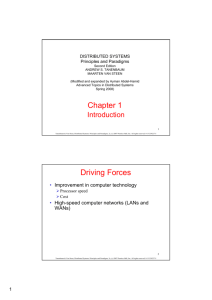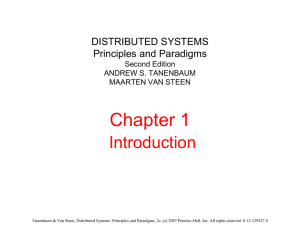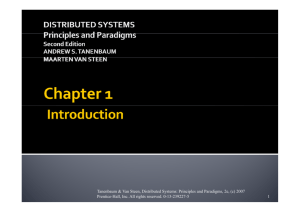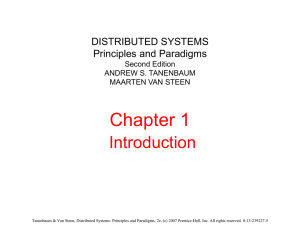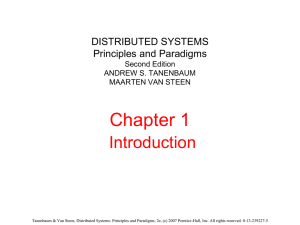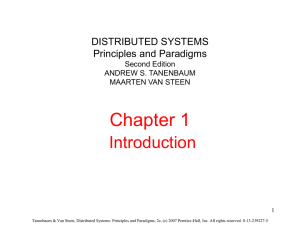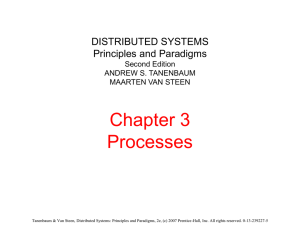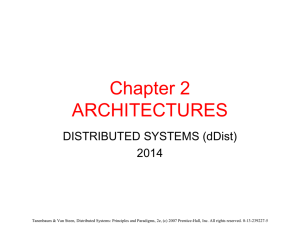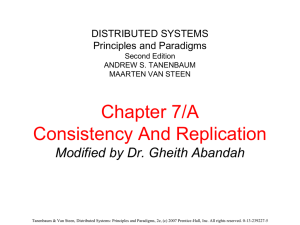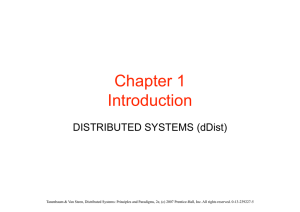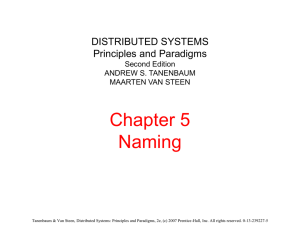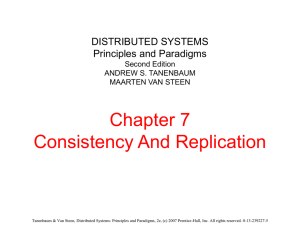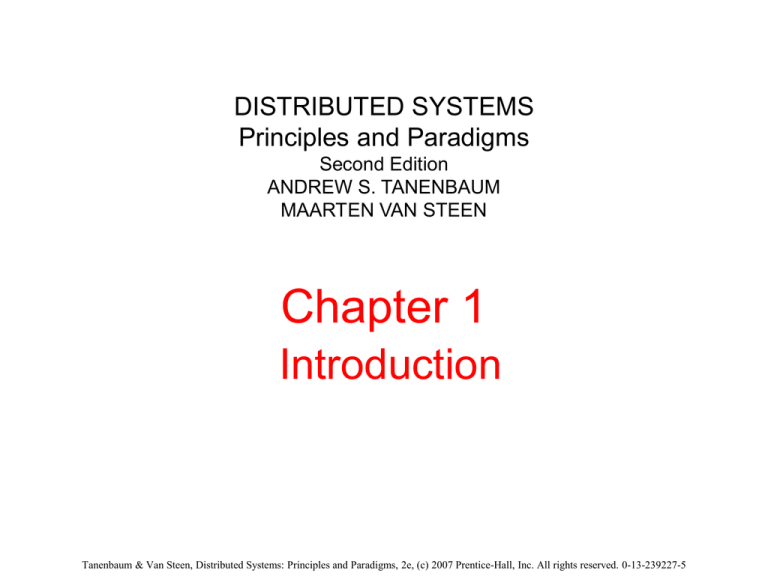
DISTRIBUTED SYSTEMS
Principles and Paradigms
Second Edition
ANDREW S. TANENBAUM
MAARTEN VAN STEEN
Chapter 1
Introduction
Tanenbaum & Van Steen, Distributed Systems: Principles and Paradigms, 2e, (c) 2007 Prentice-Hall, Inc. All rights reserved. 0-13-239227-5
Definition of a Distributed System (1)
A distributed system is:
A collection of independent
computers that appears to its
users as a single coherent
system.
Tanenbaum & Van Steen, Distributed Systems: Principles and Paradigms, 2e, (c) 2007 Prentice-Hall, Inc. All rights reserved. 0-13-239227-5
Definition of a Distributed System (2)
Figure 1-1. A distributed system organized as middleware. The
middleware layer extends over multiple machines, and offers
each application the same interface.
Tanenbaum & Van Steen, Distributed Systems: Principles and Paradigms, 2e, (c) 2007 Prentice-Hall, Inc. All rights reserved. 0-13-239227-5
Transparency in a Distributed System
Figure 1-2. Different forms of transparency in a
distributed system (ISO, 1995).
Tanenbaum & Van Steen, Distributed Systems: Principles and Paradigms, 2e, (c) 2007 Prentice-Hall, Inc. All rights reserved. 0-13-239227-5
Scalability Problems
Figure 1-3. Examples of scalability limitations.
Tanenbaum & Van Steen, Distributed Systems: Principles and Paradigms, 2e, (c) 2007 Prentice-Hall, Inc. All rights reserved. 0-13-239227-5
Scalability Problems
Characteristics of decentralized algorithms:
• No machine has complete information about the
system state.
• Machines make decisions based only on local
information.
• Failure of one machine does not ruin the
algorithm.
• There is no implicit assumption that a global
clock exists.
Tanenbaum & Van Steen, Distributed Systems: Principles and Paradigms, 2e, (c) 2007 Prentice-Hall, Inc. All rights reserved. 0-13-239227-5
Scaling Techniques (1)
Figure 1-4. The difference between letting (a) a server
or (b) a client check forms as they are being filled.
Tanenbaum & Van Steen, Distributed Systems: Principles and Paradigms, 2e, (c) 2007 Prentice-Hall, Inc. All rights reserved. 0-13-239227-5
Scaling Techniques (2)
Figure 1-5. An example of dividing the DNS
name space into zones.
Tanenbaum & Van Steen, Distributed Systems: Principles and Paradigms, 2e, (c) 2007 Prentice-Hall, Inc. All rights reserved. 0-13-239227-5
Pitfalls when Developing
Distributed Systems
False assumptions made by first time developer:
• The network is reliable.
• The network is secure.
• The network is homogeneous.
• The topology does not change.
• Latency is zero.
• Bandwidth is infinite.
• Transport cost is zero.
• There is one administrator.
Tanenbaum & Van Steen, Distributed Systems: Principles and Paradigms, 2e, (c) 2007 Prentice-Hall, Inc. All rights reserved. 0-13-239227-5
Cluster Computing Systems
Figure 1-6. An example of a cluster computing system.
Tanenbaum & Van Steen, Distributed Systems: Principles and Paradigms, 2e, (c) 2007 Prentice-Hall, Inc. All rights reserved. 0-13-239227-5
Grid Computing Systems
Figure 1-7. A layered architecture for grid computing systems.
Tanenbaum & Van Steen, Distributed Systems: Principles and Paradigms, 2e, (c) 2007 Prentice-Hall, Inc. All rights reserved. 0-13-239227-5
Transaction Processing Systems (1)
Figure 1-8. Example primitives for transactions.
Tanenbaum & Van Steen, Distributed Systems: Principles and Paradigms, 2e, (c) 2007 Prentice-Hall, Inc. All rights reserved. 0-13-239227-5
Transaction Processing Systems (2)
Characteristic properties of transactions:
• Atomic: To the outside world, the transaction
happens indivisibly.
• Consistent: The transaction does not violate
system invariants.
• Isolated: Concurrent transactions do not
interfere with each other.
• Durable: Once a transaction commits, the
changes are permanent.
Tanenbaum & Van Steen, Distributed Systems: Principles and Paradigms, 2e, (c) 2007 Prentice-Hall, Inc. All rights reserved. 0-13-239227-5
Transaction Processing Systems (3)
Figure 1-9. A nested transaction.
Tanenbaum & Van Steen, Distributed Systems: Principles and Paradigms, 2e, (c) 2007 Prentice-Hall, Inc. All rights reserved. 0-13-239227-5
Transaction Processing Systems (4)
Figure 1-10. The role of a TP monitor in distributed systems.
Tanenbaum & Van Steen, Distributed Systems: Principles and Paradigms, 2e, (c) 2007 Prentice-Hall, Inc. All rights reserved. 0-13-239227-5
Enterprise Application Integration
Figure 1-11. Middleware as a communication facilitator in
enterprise application integration.
Tanenbaum & Van Steen, Distributed Systems: Principles and Paradigms, 2e, (c) 2007 Prentice-Hall, Inc. All rights reserved. 0-13-239227-5
Distributed Pervasive Systems
Requirements for pervasive systems
•
•
•
Embrace contextual changes.
Encourage ad hoc composition.
Recognize sharing as the default.
Tanenbaum & Van Steen, Distributed Systems: Principles and Paradigms, 2e, (c) 2007 Prentice-Hall, Inc. All rights reserved. 0-13-239227-5
Electronic Health Care Systems (1)
Questions to be addressed for health care systems:
• Where and how should monitored data be
stored?
• How can we prevent loss of crucial data?
• What infrastructure is needed to generate and
propagate alerts?
• How can physicians provide online feedback?
• How can extreme robustness of the monitoring
system be realized?
• What are the security issues and how can the
proper policies be enforced?
Tanenbaum & Van Steen, Distributed Systems: Principles and Paradigms, 2e, (c) 2007 Prentice-Hall, Inc. All rights reserved. 0-13-239227-5
Electronic Health Care Systems (2)
Figure 1-12. Monitoring a person in a pervasive electronic health
care system, using (a) a local hub or
(b) a continuous wireless connection.
Tanenbaum & Van Steen, Distributed Systems: Principles and Paradigms, 2e, (c) 2007 Prentice-Hall, Inc. All rights reserved. 0-13-239227-5
Sensor Networks (1)
Questions concerning sensor networks:
• How do we (dynamically) set up an
efficient tree in a sensor network?
• How does aggregation of results take
place? Can it be controlled?
• What happens when network links fail?
Tanenbaum & Van Steen, Distributed Systems: Principles and Paradigms, 2e, (c) 2007 Prentice-Hall, Inc. All rights reserved. 0-13-239227-5
Sensor Networks (2)
Figure 1-13. Organizing a sensor network database, while storing
and processing data (a) only at the operator’s site or …
Tanenbaum & Van Steen, Distributed Systems: Principles and Paradigms, 2e, (c) 2007 Prentice-Hall, Inc. All rights reserved. 0-13-239227-5
Sensor Networks (3)
Figure 1-13. Organizing a sensor network database, while storing
and processing data … or (b) only at the sensors.
Tanenbaum & Van Steen, Distributed Systems: Principles and Paradigms, 2e, (c) 2007 Prentice-Hall, Inc. All rights reserved. 0-13-239227-5

